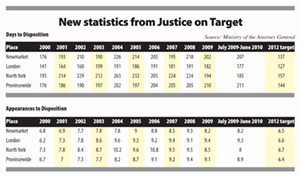Ontario’s attorney general insists the province’s Justice on Target project will hit its objectives despite mixed results revealed in new statistics.

The project, launched in June 2008, set the ambitious target of cutting both the average number of days and the number of appearances to dispose of a criminal charge by 30 per cent by June 2012 using 2007 numbers as a baseline.
But statistics released last month, taking figures up to June, show the number of appearances has fallen by just 3.3 per cent so far to 8.9 from 9.2. Meanwhile, the number of days to disposition has actually increased in the same period by 2.9 per cent to 211 from 205 in 2008.
The picture is far more encouraging in the three action sites where the government first launched the project: North York, Newmarket, and London, Ont.
In North York, the effect has been the most dramatic with a 16-per-cent drop in total appearances and an 18-per-cent decrease in days to disposition.
In Newmarket, the number of appearances is down 3.5 per cent, although the average number of days has gone up by 6.2 per cent.
In London, the number of appearances is virtually the same as it was in 2007, but the number of days to disposition has fallen by 2.2 per cent. Eight more sites joined in during 2009, and the government only rolled out the program provincewide in October.

Attorney General Chris Bentley compares the project to turning around a large ship, telling Law Times that a lot of the hard work has already been done at the action sites to identify practices that work.
Click here to see a larger version of the graph.While he expects all sites to reap the benefits over the final two years of the project, he was especially encouraged by the provincewide decline in the average number of appearances to dispose of a charge in the latest figures since that was the first time that statistic had gone down following 18 years of steady increases.
“We’ve stopped the ship,” he says. “We’ve now changed direction. And it will accelerate its pace. Once a jurisdiction figures out the most effective way to get cases dealt with, it just accelerates.”
Bentley notes the results would look even better except for bench warrants, which he blames for the continued increase in the average number of days to disposition.
He says many courthouses used Justice on Target as a spur to clear out bench warrants going back years, which meant a significant number of cases thousands of days old were technically disposed of that thereby skewed the numbers.
Bentley notes the progress at the North York courthouse in Toronto gives him particular confidence that the targets are realistic. “They deal with some very challenging neighbourhoods. They’re down almost 20 per cent, and I didn’t give them any extra Crowns or a single extra judge. It shows that it can be done.”
But MPP Ted Chudleigh, attorney general critic for the provincial Conservatives, describes the gains as “modest” and fears any improvements have come at the expense of weak plea bargains and leniently dropped charges.
He highlights the case of Tzvi Erez, a Toronto man accused of defrauding investors of $27 million in an alleged Ponzi scheme. Charges against him were dropped, and a leaked e-mail from a Crown attorney suggested competition over trial time was a factor.
“As noble as it is in theory, I don’t think this program is doing justice a very good turn in Ontario,” Chudleigh says. “It’s been poorly implemented, and I don’t think there’s been good direction going along with it.”
Chudleigh worries the public won’t be served if Crown attorneys are pressured to dispose of cases quickly. “Clearing the slate is not the purpose of the case. The purpose is to bring justice to Ontario. I’m afraid it’s being abused in that area.”
But Bentley insists the speed of the decisions under Justice on Target doesn’t affect the outcome of cases. In the past, he says matters that didn’t need a trial would be scheduled for one anyway only to reach a resolution on the eve of proceedings.
Justice on Target gets Crown attorneys involved earlier in the process to advise police on whether a charge will stand up in court.
“What we’re doing is saying, ‘Rather than making the decision on the day of trial, make the same decision, but earlier, before you adjourn the case a dozen times.’ That’s what’s happening,” Bentley says.
He adds that the reduced number of appearances has freed up the court’s resources for the cases that require the most attention. According to Bentley, a one-day trial in Newmarket can now be scheduled within a few months when it could have taken up to a year before the project.
“As a Crown attorney, I don’t think your time is best spent shuffling cases just to adjourn them from one day to the next. It can give you that extra time with a victim of a sex assault or figuring out a fine point of law on a case that needs to go to trial.”
At the same time, Bentley says it has been particularly difficult to bring together the many parties involved in the justice system, including Crown attorneys, defence lawyers, judges, police, and correctional officers.
“Even accepting that there are different loyalties, there are ways we can make the system work more effectively for all. What’s unique about this is we brought everyone to the same table as equals. We’re changing the culture, and culture change is never fast and it’s never easy.”
For more on this issue, see "
Defence counsel part of 'weak link' in Justice on Target."

 The project, launched in June 2008, set the ambitious target of cutting both the average number of days and the number of appearances to dispose of a criminal charge by 30 per cent by June 2012 using 2007 numbers as a baseline.
The project, launched in June 2008, set the ambitious target of cutting both the average number of days and the number of appearances to dispose of a criminal charge by 30 per cent by June 2012 using 2007 numbers as a baseline.  Attorney General Chris Bentley compares the project to turning around a large ship, telling Law Times that a lot of the hard work has already been done at the action sites to identify practices that work.
Attorney General Chris Bentley compares the project to turning around a large ship, telling Law Times that a lot of the hard work has already been done at the action sites to identify practices that work.